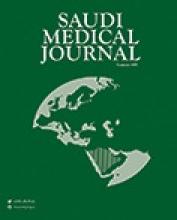Abstract
OBJECTIVE: To assess the diagnostic yield and safety of flexible fiberoptic bronchoscopy (FFB).
METHODS: A retrospective review of bronchoscopy reports and corresponding patients charts over 3 years from January 2004 - December 2006 in King Khalid University Hospital, Riyadh, Kingdom of Saudi Arabia. Indication for procedure, suspected diagnosis, final diagnosis, and complications were reported.
RESULTS: Out of 720 patients, 707 (98.2%) patients had a full follow up. Five hundred and ninety-two (83.7%) underwent FFB for diagnostic purposes and 115 (16.3%) for therapeutic purposes. The mean age was 42 -/+ 18 years. Infection, including mycobacterium tuberculosis, and malignancy were the 2 main indications for FFB (35.9% and 25.9%). The overall diagnostic yield was 58%. Tuberculosis was diagnosed in 67% of suspected cases, whereas bacterial pneumonia was diagnosed in 40.5%. Malignancy was confirmed in 61.2% of suspected cases. Bronchoscopy diagnosed 37 (43%) of 86 patients with interstitial lung disease. The diagnostic yield was 57% for sarcoidosis, 40% for usual interstitial pneumonia and 88% for bronchiolitis obliterans organizing pneumonia. The overall complication rate was 5%; pneumothorax occurred in 0.56% and was associated exclusively with transbronchial biopsy. No mortality was observed.
CONCLUSION: Flexible fiberoptic bronchoscopy is a useful diagnostic tool with a low rate of complications. The diagnostic yield in our institution is similar to that reported in Western series.
- Copyright: © Saudi Medical Journal
This is an open-access article distributed under the terms of the Creative Commons Attribution-Noncommercial-Share Alike 3.0 Unported, which permits unrestricted use, distribution, and reproduction in any medium, provided the original work is properly cited.






